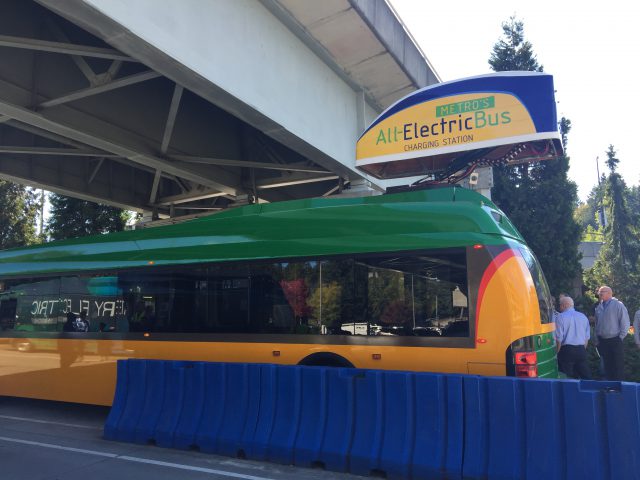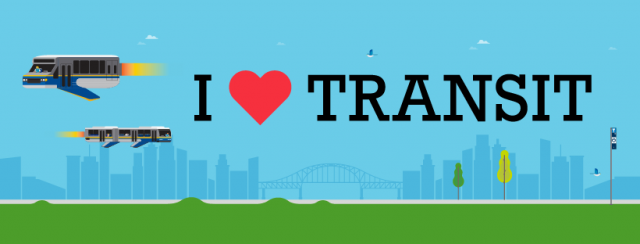I Love Transit 2017: Electric buses—exploring the transit industry’s next frontier with our customers
I Love Transit 2017: Electric buses—exploring the transit industry’s next frontier with our customers



It’s I Love Transit Week! A week where we celebrate our riders, transit enthusiasts and all the things we love about transit. For the first time this year, we have a theme: Beyond—the future of transportation in Metro Vancouver. Battery-electric buses are poised to be the next big leap in technology for the transit industry, so we decided to ask a planner to explain what it means for us!

By David Cooper, senior planner, TransLink
One of the exciting technology advances in the public transit world is the deployment of battery-electric buses.
As we are seeing a transition in the auto industry from the internal combustion engine to electricity, transit agencies including TransLink are exploring the suitability of adopting this technology for our future bus fleet.
Now, electric buses are not entirely new in Metro Vancouver.
TransLink has an extensive electric trolley bus fleet where our 262 electric trolley buses serve 13 high ridership routes in Vancouver and Burnaby. Up to 50 per cent of our current bus fleet feature cleaner technologies including compressed natural gas and diesel-electric hybrids in addition to our electric trolley buses.
Over in neighbouring King County Metro Transit in Seattle, they are currently proceeding with the largest order of battery-electric buses to date in North America with the deployment of 120 of these buses by 2020. We are monitoring the development and deployment of battery-electric buses in Seattle and cities such as Montreal.
Presently, there are two types of battery-electric buses: slow charge and fast charge.
Slow-charge battery-electric buses charge their batteries while the bus is parked at the garage (in between peak periods or overnight). Fast-charge battery-electric buses receive a charge from an on-route charging station (typically at the end of the route).
Earlier this year, we conducted a three month pilot of a slow-charge battery-electric bus in Vancouver. Next year, we are looking to pilot fast charge buses with on-route charging stations. These pilots provide us with an on-the-ground experience with this technology. Pilots allow us to assess how these buses work for our transit operators and maintenance personnel, as well as our transit customers.
Prior to the decision for the deployment of battery-electric buses, TransLink will fully assess the benefits and impacts of this technology which could include:
- Overall reduction of greenhouse gas emissions when compared to other fuel types;
- Analysis on the impact of operations with battery-electric buses (e.g. ability of the buses to have suitable range to provide service on routes across our region, ability to install charging equipment at our depots and/or on-route at key points); and
- Potential costs for battery-electric buses, charging infrastructure, operations and maintenance support.
You’ll want to stay tuned to the Buzzer blog for future updates on our exploration and advancement on this technology and its potential ability to further “green” our fleet and operations in the future.
We are excited to explore this new frontier in the transit industry with our customers!
Looking for more ways to celebrate I Love Transit week? Check out the blog for more opportunities to share your stories and win! Follow along on Facebook, Twitter and Instagram too!







There is an option which has not been covered. Both battery buses and hybrid buses will often find themselves underneath overhead wires, which will continue to be in use for the remaining life of the trolleybus fleet. Fitting poles to both hybrid and battery buses would both decrease the emissions of diesel exhaust from the former and increase the range of the latter. The use of regenerative braking on both types would reduce power drawn from the grid.
Vossloh Kiepe (the maker of the propulsion equipment for NFI’s trolleybuses) actually has a system called In-Motion Charging which is pretty much precisely that. I actually think this ststem makes a lot of sense for Vancouver as a medium-to-long-term solution, given our history of trolleybus operations.
I’d support looking to using the trolley overhead to charge electric battery buses. For example, 41st avenue has trolley wires from Crown to Joyce but no revenue service uses them. Imagine converting the 41 Joyce-UBC to electric battery bus that runs on trolley overhead to Crown, then on battery to UBC and back to Crown. Same for the night operation of the 210 when it runs local and takes over the No.4 to downtown – it could run battery to Renfrew, then on overhead wires to downtown. Lots of options to maximize use of trolley overhead too.